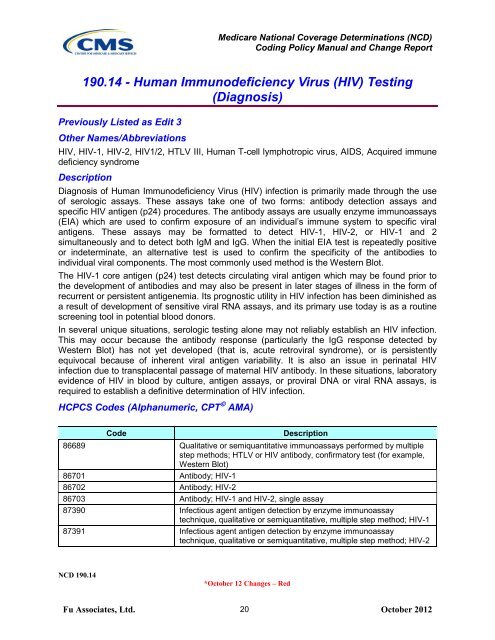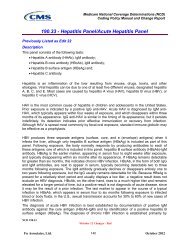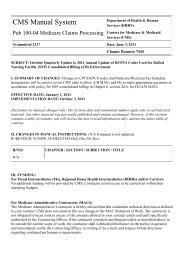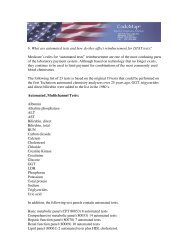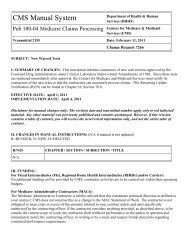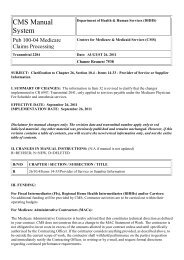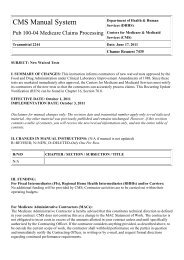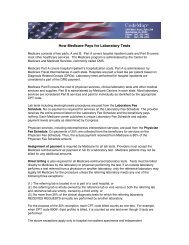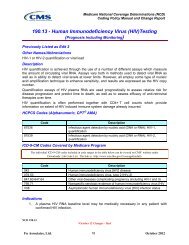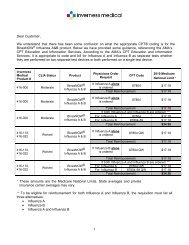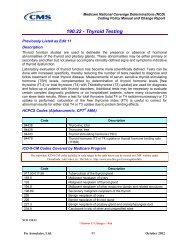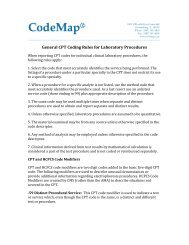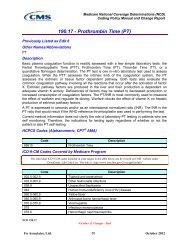NCD 190.14 - CodeMap
NCD 190.14 - CodeMap
NCD 190.14 - CodeMap
Create successful ePaper yourself
Turn your PDF publications into a flip-book with our unique Google optimized e-Paper software.
This is CMS Logo.Medicare National Coverage Determinations (<strong>NCD</strong>)Coding Policy Manual and Change Report<strong>190.14</strong> - Human Immunodeficiency Virus (HIV) Testing(Diagnosis)Previously Listed as Edit 3Other Names/AbbreviationsHIV, HIV-1, HIV-2, HIV1/2, HTLV III, Human T-cell lymphotropic virus, AIDS, Acquired immunedeficiency syndromeDescriptionDiagnosis of Human Immunodeficiency Virus (HIV) infection is primarily made through the useof serologic assays. These assays take one of two forms: antibody detection assays andspecific HIV antigen (p24) procedures. The antibody assays are usually enzyme immunoassays(EIA) which are used to confirm exposure of an individual’s immune system to specific viralantigens. These assays may be formatted to detect HIV-1, HIV-2, or HIV-1 and 2simultaneously and to detect both IgM and IgG. When the initial EIA test is repeatedly positiveor indeterminate, an alternative test is used to confirm the specificity of the antibodies toindividual viral components. The most commonly used method is the Western Blot.The HIV-1 core antigen (p24) test detects circulating viral antigen which may be found prior tothe development of antibodies and may also be present in later stages of illness in the form ofrecurrent or persistent antigenemia. Its prognostic utility in HIV infection has been diminished asa result of development of sensitive viral RNA assays, and its primary use today is as a routinescreening tool in potential blood donors.In several unique situations, serologic testing alone may not reliably establish an HIV infection.This may occur because the antibody response (particularly the IgG response detected byWestern Blot) has not yet developed (that is, acute retroviral syndrome), or is persistentlyequivocal because of inherent viral antigen variability. It is also an issue in perinatal HIVinfection due to transplacental passage of maternal HIV antibody. In these situations, laboratoryevidence of HIV in blood by culture, antigen assays, or proviral DNA or viral RNA assays, isrequired to establish a definitive determination of HIV infection.HCPCS Codes (Alphanumeric, CPT AMA)CodeDescription86689 Qualitative or semiquantitative immunoassays performed by multiplestep methods; HTLV or HIV antibody, confirmatory test (for example,Western Blot)86701 Antibody; HIV-186702 Antibody; HIV-286703 Antibody; HIV-1 and HIV-2, single assay87390 Infectious agent antigen detection by enzyme immunoassaytechnique, qualitative or semiquantitative, multiple step method; HIV-187391 Infectious agent antigen detection by enzyme immunoassaytechnique, qualitative or semiquantitative, multiple step method; HIV-2<strong>NCD</strong> <strong>190.14</strong>*October 12 Changes – RedFu Associates, Ltd. 20 October 2012
This is CMS Logo.Medicare National Coverage Determinations (<strong>NCD</strong>)Coding Policy Manual and Change ReportCodeDescription87534 Infectious agent detection by nucleic acid (DNA or RNA); HIV-1, directprobe technique87535 Infectious agent detection by nucleic acid (DNA or RNA); HIV-1,amplified probe technique87537 Infectious agent detection by nucleic acid (DNA or RNA); HIV-2, directprobe technique87538 Infectious agent detection by nucleic acid (DNA or RNA); HIV-2,amplified probe techniqueICD-9-CM Codes Covered by Medicare ProgramThe individual ICD-9-CM codes included in code ranges in the table below can be viewed on CMS’ website underDownloads: Lab Code List. The link is: http://www.cms.hhs.gov/CoverageGenInfoCodeDescription003.1 Salmonella septicemia007.2 Coccidiosis (Isoporiasis)007.4 Cryptosporidiosis007.8 Other specified protozoal intestinal diseases010.00-010.96 Primary tuberculous infection011.00-011.96 Pulmonary tuberculosis012.00-012.86 Other respiratory tuberculosis013.00-013.96 Tuberculosis of meninges--+ and central nervous system014.00-014.86 Tuberculosis of intestines, peritoneum and mesenteric glands015.00-015.96 Tuberculosis of bones and joints016.00-016.96 Tuberculosis of genitourinary system017.00-017.96 Tuberculosis of other organs018.00-018.96 Miliary tuberculosis027.0 Listeriosis031.0-031.9 Diseases due to other mycobacteria038.2 Pneumococcal septicemia038.43 Septicemia (Pseudomonas)039.0-039.9 Actinomycotic infections (includes Nocardia)041.7 Pseudomonas infection042 HIV disease (Acute retroviral syndrome, AIDS-related complex)046.3 Progressive multifocal leukoencephalopathy049.0-049.9 Other non-arthropod-borne viral diseases of central nervous system052.0-052.1, 052.2, 052.7- Chickenpox (with complication)052.8053.0, 053.10-053.13,053.14, Herpes zoster053.19-053.22, 053.29,053.71,053.79, 053.8, 053.9<strong>NCD</strong> <strong>190.14</strong>*October 12 Changes – RedFu Associates, Ltd. 21 October 2012
This is CMS Logo.Medicare National Coverage Determinations (<strong>NCD</strong>)Coding Policy Manual and Change ReportCodeDescription054.0, 054.10-054.13, Herpes simplex054.19, 054.2, 054.3,054.40-054.44, 054.49,054.5, 054.6, 054.7-054.73,054.74, 054.79, 054.8, 054.9055.0-055.8 Measles (with complication)070.20-070.23 Viral hepatitis B with hepatic coma070.30-070.33 Viral hepatitis B without mention of hepatic coma070.41 Acute hepatitis C with hepatic coma070.42 Hepatitis delta without mention of active hepatitis B disease withhepatic coma070.44 Chronic hepatitis C with hepatic coma070.49 Other specified viral hepatitis with hepatic coma070.51 Acute hepatitis C without mention of hepatic coma070.52 Hepatitis delta without mention of active hepatitis B disease withouthepatic coma070.54 Chronic hepatitis C without hepatic coma070.59 Other specified viral hepatitis without hepatic coma070.6 Unspecified viral hepatitis with hepatic coma070.70 Unspecified viral hepatitis C without hepatic coma070.71 Unspecified viral hepatitis C with hepatic coma070.9 Unspecified viral hepatitis without hepatic coma078.0 Molluscum contagiosum078.10 – 078.19 Viral warts078.3 Cat-scratch disease078.5 Cytomegaloviral disease078.88 Other specified diseases due to Chlamydiae079.50 Retrovirus unspecified079.51 HTLV-I079.52 HTLV-II079.53 Human immunodeficiency virus, type 2079.59 Other specified Retrovirus079.83 Parvovirus B19079.88 Other specified chlamydial infection079.98 Unspecified chlamydial infection085.0-085.9 Leishmaniasis088.0 Bartonellosis090.0-090.9 Congenital syphilis091.0-091.9 Early syphilis symptomatic092.0-092.9 Early syphilis, latent093.0-093.9 Cardiovascular syphilis094.0-094.9 Neurosyphilis<strong>NCD</strong> <strong>190.14</strong>*October 12 Changes – RedFu Associates, Ltd. 22 October 2012
This is CMS Logo.Medicare National Coverage Determinations (<strong>NCD</strong>)Coding Policy Manual and Change ReportCodeDescription095.0-095.9 Other forms of late syphilis, with symptoms096 Late syphilis, latent097.0-097.9 Other and unspecified syphilis098.0-098.89 Gonococcal infections099.0 Chancroid099.1 Lymphogranuloma venereum099.2 Granuloma inguinale099.3 Reiter’s disease099.40-099.49 Other nongonococcal urethritis099.50-099.59 Other venereal diseases due to Chlamydia trachomatis099.8 Other specified venereal diseases099.9 Venereal disease, unspecified110.1 Dermatophytosis of nail111.0 Pityriasis versicolor112.0-112.9 Candidiasis114.0-114.9 Coccidioidomycosis115.00-115.99 Histoplasmosis116.0-116.2 Blastomycotic infection117.3 Aspergillosis117.5 Cryptococcosis118 Opportunistic mycoses127.2 Strongyloidiasis130.0-130.9 Toxoplasmosis131.01 Trichomonal vulvovaginitis132.2 Phthirus pubis133.0 Scabies136.21 Specific infection due to acanthamoeba136.29 Other specific infections by free-living amebae136.3 Pneumocystosis136.8 Other specified infectious and parasitic disease (i.e.: microsporidiosis)176.0-176.9 Kaposi’s sarcoma180.0-180.9 Malignant neoplasm of cervix uteri200.20-200.28 Burkitt’s tumor or lymphoma200.80-200.88 Lymphosarcoma, other named variants201.00-201.98 Hodgkin’s disease263.0 Malnutrition of moderate degree263.1 Malnutrition of mild degree263.9 Unspecified protein-calorie malnutrition280.0-280.9 Iron deficiency anemias285.9 Anemia, unspecified287.30-287.39 Primary thrombocytopenia<strong>NCD</strong> <strong>190.14</strong>*October 12 Changes – RedFu Associates, Ltd. 23 October 2012
This is CMS Logo.Medicare National Coverage Determinations (<strong>NCD</strong>)Coding Policy Manual and Change ReportCodeDescription288.00 Neutropenia, unspecified288.01 Congenital neutropenia288.02 Cyclic neutropenia288.03 Drug induced neutropenia288.04 Neutropenia due to infection288.09 Other neutropenia288.4 Hemophagocytic syndromes288.50 Leukocytopenia, unspecified288.51 Lymphocytopenia288.59 Other decreased white blood cell count288.60 Leukocytosis, unspecified288.61 Lymphocytosis (symptomatic)288.62 Leukemoid reaction288.63 Monocytosis (symptomatic)288.64 Plasmacytosis288.65 Basophilia288.66 Bandemia288.69 Other elevated white blood cell count288.8 Other specified disease of white blood cells289.53 Neutropenic splenomegaly294.8 Other persistent mental disorders due to conditions classifiedelsewhere310.1 Personality change due to conditions classified elsewhere322.2 Chronic meningitis331.19 Other frontotemporal dementia331.83 Mild cognitive impairment, so stated336.9 Unspecified disease of spinal cord348.30 Encephalopathy unspecified348.39 Other encephalopathy354.0-354.9 Mononeuritis of upper limbs and mononeuritis multiplex356.8 Other specified idiopathic peripheral neuropathy363.20 Chorioretinitis, unspecified425.4 Other primary cardiomyopathies473.0-473.9 Chronic sinusitis481-482.41 Pneumococcal pneumonia and other bacterial pneumonia482.42 Methicillin resistant pneumonia due to Staphylococcus aureus482.49-482.9 Other pneumonia due to Staphylococcus, specified and unspecified484.1 Pneumonia in cytomegalic inclusion disease486 Pneumonia, organism unspecified512.81 Primary spontaneous pneumothorax512.82 Secondary spontaneous pneumothorax<strong>NCD</strong> <strong>190.14</strong>*October 12 Changes – RedFu Associates, Ltd. 24 October 2012
This is CMS Logo.Medicare National Coverage Determinations (<strong>NCD</strong>)Coding Policy Manual and Change ReportCodeDescription512.83 Chronic pneumothorax516.8 Other specified alveolar and parietoalveolar pneumonopathies528.2 Oral aphthae528.6 Leukoplakia of oral mucosa530.20-530.21 Ulcer of esophagus530.85 Barrett’s esophagus583.9 Nephropathy with unspecified pathological lesion in kidney588.81 Secondary hyperparathyroidism (of renal origin)588.89 Other specified disorders resulting from impaired renal function647.60-647.64 Other viral diseases complicating pregnancy (use for HIV I and II)682.0-682.9 Other cellulitis and abscess690.10-690.18 Seborrheic dermatitis696.1 Other psoriasis698.3 Lichenification and lichen simplex chronicus704.8 Other specified diseases of hair and hair follicles706.0-706.9 Diseases of sebaceous glands780.60 Fever, unspecified780.61 Fever presenting with conditions classified elsewhere780.62 Postprocedural fever780.63 Postvaccination fever780.64 Chills (without fever)780.65 Hypothermia not associated with low environmental temperature780.66 Febrile nonhemolytic transfusion reaction780.79 Other malaise and fatigue783.21 Abnormal loss of weight783.40 Lack of expected normal physiological development785.6 Enlargement of lymph nodes786.00 Respiratory abnormality, unspecified786.05 Shortness of breath786.2 Cough786.30 Hemoptysis, unspecified786.31 Acute idiopathic pulmonary hemorrhage in infants (AIPHI)786.39 Other hemoptysis786.4 Abnormal sputum787.91 Diarrhea795.71 Nonspecific serologic evidence of human immunodeficiency virus799.4 Wasting diseaseV01.71 Contact or exposure to varicellaV01.79 Contact or exposure to other viral diseasesV71.5 Rape<strong>NCD</strong> <strong>190.14</strong>*October 12 Changes – RedFu Associates, Ltd. 25 October 2012
This is CMS Logo.Medicare National Coverage Determinations (<strong>NCD</strong>)Coding Policy Manual and Change Report6. If initial serologic tests are HIV EIA negative and there is no indication for confirmationof infection by viral RNA detection, the interval prior to retesting is 3-6 months.7. Testing for evidence of HIV infection using serologic methods may be medicallyappropriate in situations where there is a risk of exposure to HIV. However, in theabsence of a documented AIDS defining or HIV-associated disease, an HIV-associatedsign or symptom, or documented exposure to a known HIV-infected source, the testingis considered by Medicare to be screening and thus is not covered by Medicare (forexample, history of multiple blood component transfusions, exposure to blood or bodyfluids not resulting in consideration of therapy, history of transplant, history of illicit druguse, multiple sexual partners, same-sex encounters, prostitution, or contact withprostitutes).8. The CPT Editorial Panel has issued a number of codes for infectious agent detectionby direct antigen or nucleic acid probe techniques that have not yet been developed orare only being used on an investigational basis. Laboratory providers are advised toremain current on FDA-approval status for these tests.ICD-9-CM Codes That Do Not Support Medical NecessityAny ICD-9-CM code not listed in either of the ICD-9-CM covered or non-covered sections.Documentation RequirementsAppropriate HCPCS/CPT code (s) must be used as described.Sources of InformationCDC, 1993. Revised classification system for HIV infection and expanded surveillance casedefinition for AIDS among adolescents and adults. MMWR 41 (No. RR17).CDC, 1994. Revised classification system for human immunodeficiency virus infection inchildren less than 13 years of age.CDC, 1998. Guidelines for treatment of sexually transmitted diseases. MMWR 47 (RR1):11-17.Piatak, M., M.S. Saag, L.C. Yang, et al. 1993. High levels of HIV-1 in plasma during all stages ofinfection determined by competitive PCR. Science 259:1749-1754.Rhame, R.S. 1994. Acquired immunodeficiency syndrome, p. 628-652. In Infectious Diseases;P.D. Hoeprich, M.C. Jordan, and A.R. Ronald (J.B. Lippincott Co., Philadelphia).Vasudevachari, M.D., R.T. Davey, Jr., J.A. Metcalf, and H.C. Lane. 1997. Principles andprocedures of human immunodeficiency virus serodiagnosis. In Manual of Clinical LaboratoryImmunology (Fifth ed.); N.R. Rose, E.C. de Macario, J.D. Folds, H.C. Lane, and R.M. Nakamura(ASM Press, Washington, DC).<strong>NCD</strong> <strong>190.14</strong>*October 12 Changes – RedFu Associates, Ltd. 27 October 2012


